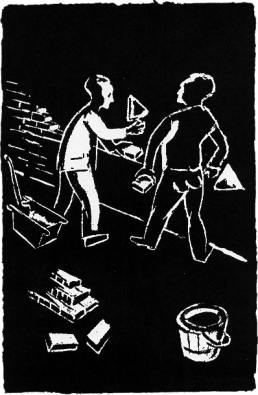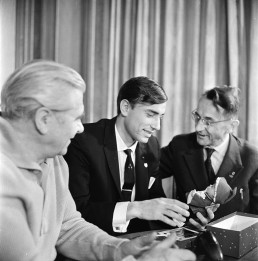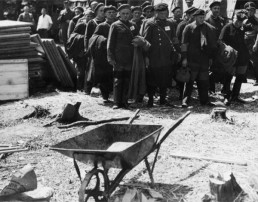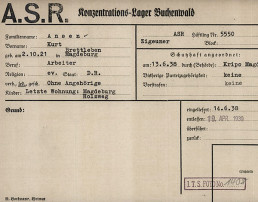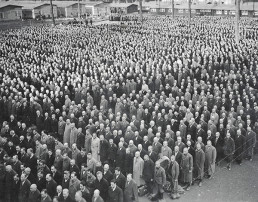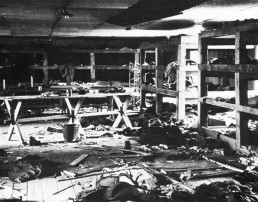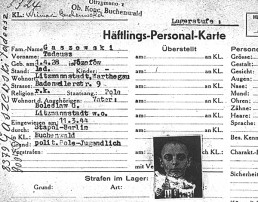Rescue Initiatives: Bricklayers’ school and Poles’ school
Under the pretext of training skilled workers for the German war effort, prisoner functionaries around Robert Siewert, a political prisoner and Kapo of the construction detail, launched a rescue initiative for young Polish prisoners in the fall of 1939. They convinced the SS of the idea of an apprentice masonry detail. The bricklayers’ school was intended to protect the minors from the exhausting forced labor in other work details.
In the spring of 1942, other political prisoners who were prisoner functionaries succeeded in setting up the Poles’ School. Under the pretext of having to overcome language difficulties in the labor details, they organized German lessons for the boys. The Poles’ School was also meant to protect them from the exhausting forced labor.
The bricklayers’ and Poles’ schools increased the chances of survival in the camp, especially for Polish, and later also for Jewish, children and teenagers.
Rescue by the bricklayers’ Detail. Woodcut Durch Arbeit from the series "A Friendship" by Herbert Sandberg, 1947/49
The German graphic artist, cartoonist, and resistance fighter Herbert Sandberg (1908-1991) endured ten years of imprisonment, the last seven in the Buchenwald Concentration Camp. In April 1944, while in Buchenwald, he drew a series of sketches recounting his journey since he was first incarcerated in July 1938. He worked with stove soot and whiting on paper and linen remnants. Sandberg was trained as a bricklayer in a group of Jewish prisoners in 1941 – this saved him, as a “useful worker,” from deportation to Auschwitz. After liberation, he published the drawings he made in Buchenwald in a collection of his works.
(Buchenwald Memorial)
"The communists in the prisoner self-administration obtained [...] permission from the SS to set up a bricklayers’ school by claiming there was a shortage of skilled workers for camp construction. Officially, the school was intended to train new workers for the construction detail, so it was supervised by that detail and the teacher was the Kapo of the Kommando Maurer Truppengarage (garage bricklayers) detail, Robert Siewert. [...] It was in this school that we survived the first Thuringian winter."
Report by Władysław Kożdoń, 2006.
Polish Boy Scout Władysław Kożdoń (1922-2017) was sent to the Buchenwald Concentration Camp in October 1939, shortly after his 17th birthday, and was sent to the bricklayers’ school.
(Władysław Kożdoń, „…ich kann dich nicht vergessen“. Erinnerungen an Buchenwald, Göttingen 2007)
Robert Siewert (left) in conversation with the "Buchenwald child" Stefan Jerzy Zweig uand Bruno Apitz (right) in Weimar, 9 February 1964.
Robert Siewert (1887-1973) used his position as Kapo of a construction detail to initiate the bricklaying school. In 1945 he became Minister of Interior Affairs in Saxony-Anhalt, but lost this post in 1950 as part of Stalinist purges within the SED. He later worked in the GDR’s Ministry of Construction.
(Photo: Friedrich Gahlbeck, Bundesarchiv)
"We learned new vocabulary in German and had to repeat it several times. In class we dealt with grammar, spelling and reading. We also wrote dictations. We wrote on slates with styluses, read from the blackboard and from some books. There weren’t many books. We put sentences together, and the advanced students wrote summaries in German in their notebooks."
Włodzimierz Kuliński's recollections of lessons at the Polish School, undated.
Włodzimierz Kuliński was deported from Poland to Buchenwald when he was 15 years old. German lessons were given by two Polish prisoners. On 29 November 1941, the young Polish teacher Henryk Sokolak was appointed head of the Polish School with the support of the camp elder Ernst Busse. Due to the boys’ different levels of education, Sokolak divided them into two groups so that he could teach them better.
(Buchenwald Memorial)
Children in the Buchenwald Concentration Camp
Aktion Arbeitsscheu Reich 1938
In 1938, the number of prisoners in the concentration camps doubled. As part of the Aktion Arbeitsscheu Reich (Operation Work-Shy Reich, two waves of arrests of purported “anti-social…
1938: Deported to Buchenwald as “special operation Jews”
In the course of the November pogroms of 1938, the Gestapo sent 30,000 Jews, designated by the SS as “special operation Jews,” to concentration camps.
Limited shelter: The children’s blocks 8 and 66
Children were particularly vulnerable to the dangers of the camp. To protect them, political prisoner functionaries set up a children's block in Block 8 of the main camp in July 1943.
Deterrence through forced labor: Disciplinary work prisoners
From 1941 to 1944, a Gestapo labor re-education camp existed at the Buchenwald Concentration Camp.
